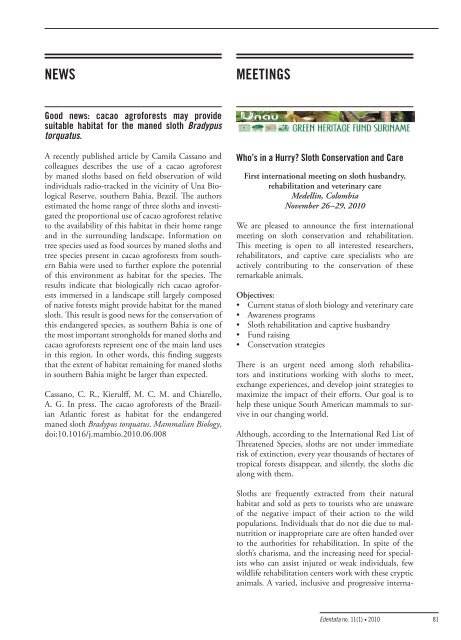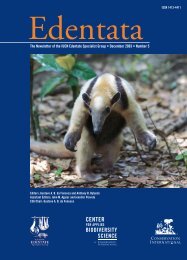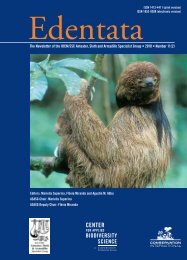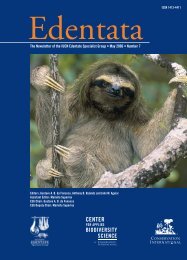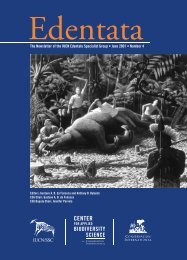Edentata 11(1) - Anteater, Sloth & Armadillo Specialist Group
Edentata 11(1) - Anteater, Sloth & Armadillo Specialist Group
Edentata 11(1) - Anteater, Sloth & Armadillo Specialist Group
Create successful ePaper yourself
Turn your PDF publications into a flip-book with our unique Google optimized e-Paper software.
NEWS<br />
MEETINGS<br />
Good news: cacao agroforests may provide<br />
suitable habitat for the maned sloth Bradypus<br />
torquatus.<br />
A recently published article by Camila Cassano and<br />
colleagues describes the use of a cacao agroforest<br />
by maned sloths based on field observation of wild<br />
individuals radio-tracked in the vicinity of Una Biological<br />
Reserve, southern Bahia, Brazil. The authors<br />
estimated the home range of three sloths and investigated<br />
the proportional use of cacao agroforest relative<br />
to the availability of this habitat in their home range<br />
and in the surrounding landscape. Information on<br />
tree species used as food sources by maned sloths and<br />
tree species present in cacao agroforests from southern<br />
Bahia were used to further explore the potential<br />
of this environment as habitat for the species. The<br />
results indicate that biologically rich cacao agroforests<br />
immersed in a landscape still largely composed<br />
of native forests might provide habitat for the maned<br />
sloth. This result is good news for the conservation of<br />
this endangered species, as southern Bahia is one of<br />
the most important strongholds for maned sloths and<br />
cacao agroforests represent one of the main land uses<br />
in this region. In other words, this finding suggests<br />
that the extent of habitat remaining for maned sloths<br />
in southern Bahia might be larger than expected.<br />
Cassano, C. R., Kierulff, M. C. M. and Chiarello,<br />
A. G. In press. The cacao agroforests of the Brazilian<br />
Atlantic forest as habitat for the endangered<br />
maned sloth Bradypus torquatus. Mammalian Biology,<br />
doi:10.1016/j.mambio.2010.06.008<br />
Who’s in a Hurry? <strong>Sloth</strong> Conservation and Care<br />
First international meeting on sloth husbandry,<br />
rehabilitation and veterinary care<br />
Medellin, Colombia<br />
November 26–29, 2010<br />
We are pleased to announce the first international<br />
meeting on sloth conservation and rehabilitation.<br />
This meeting is open to all interested researchers,<br />
rehabilitators, and captive care specialists who are<br />
actively contributing to the conservation of these<br />
remarkable animals.<br />
Objectives:<br />
• Current status of sloth biology and veterinary care<br />
• Awareness programs<br />
• <strong>Sloth</strong> rehabilitation and captive husbandry<br />
• Fund raising<br />
• Conservation strategies<br />
There is an urgent need among sloth rehabilitators<br />
and institutions working with sloths to meet,<br />
exchange experiences, and develop joint strategies to<br />
maximize the impact of their efforts. Our goal is to<br />
help these unique South American mammals to survive<br />
in our changing world.<br />
Although, according to the International Red List of<br />
Threatened Species, sloths are not under immediate<br />
risk of extinction, every year thousands of hectares of<br />
tropical forests disappear, and silently, the sloths die<br />
along with them.<br />
<strong>Sloth</strong>s are frequently extracted from their natural<br />
habitat and sold as pets to tourists who are unaware<br />
of the negative impact of their action to the wild<br />
populations. Individuals that do not die due to malnutrition<br />
or inappropriate care are often handed over<br />
to the authorities for rehabilitation. In spite of the<br />
sloth’s charisma, and the increasing need for specialists<br />
who can assist injured or weak individuals, few<br />
wildlife rehabilitation centers work with these cryptic<br />
animals. A varied, inclusive and progressive interna-<br />
<strong>Edentata</strong> no. <strong>11</strong>(1) • 2010 81


